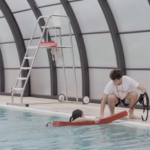As the summer approaches, there is a growing concern that public swimming pools across America may be closed again due to a lifeguard shortage. The shortage of lifeguards has been an ongoing issue, with about a third of the country’s 309,000 public swimming pools remaining closed or opened sporadically last year due to the shortage. This year, the situation could be “as bad as last year, or worse,” warns B.J. Fisher, the director of health and safety for the American Lifeguard Association. This shortage poses a safety concern for people seeking refuge from the summer heat.
In this article, we will explore the reasons behind the lifeguard shortage, its impact, and how communities can address the problem.
Reasons for the Lifeguard Shortage
Lifeguarding is often viewed as a summer job for young teenagers, and it is not considered a career by many. According to Fisher, communities need to view lifeguarding as an essential job and part of a community’s emergency response team.
To fix the problems contributing to the shortage, Fisher suggests that lifeguards should be trained as such, and even youth should be trained in first aid. By promoting lifeguarding as a career option and not just a summer job, communities can attract more people to the profession and ensure there are enough lifeguards to keep public pools open.
The COVID-19 pandemic has also impacted the lifeguard shortage. Social distancing meant fewer training opportunities for new lifeguards and recertification. Typically, about 300,000 new candidates are trained every year through various programs. The pandemic has disrupted the training programs, resulting in fewer candidates being trained.
Impact of the Shortage
The shortage of lifeguards has a significant impact on the community. Public pools serve as places to meet friends and neighbors and have clean fun in a secure area. Without enough lifeguards to keep pools open, Fisher fears that kids who don’t have access to backyard pools or country club memberships will find more dangerous, unmonitored places to cool off. This could pose a significant safety risk, and the consequences could be severe.
Addressing the Problem
Communities can take various steps to address the problem of the shortage of lifeguards. One of the ways is to promote lifeguarding as a career option and not just as a summer job. This can be done by offering more training opportunities and providing incentives to attract more people to the profession. Offering free lifeguard training to anyone who wants to sign up and providing bonuses to fill lifeguard positions are some of the measures communities can take.
Moreover, communities can train youth in first aid and emergency response, creating a pipeline of qualified lifeguards for the future. By starting early, communities can encourage young people to consider lifeguarding as a career and ensure there are enough lifeguards to meet the demand.
Addressing the Problem with Innovative Solutions
The lifeguard shortage has led to some innovative solutions in communities across America. In some places, retired firefighters and other emergency responders have been recruited to work as lifeguards. This not only helps to address the labor shortage but also brings in experienced professionals who are well-equipped to handle emergencies.
Another solution is to provide more flexible scheduling for lifeguards. Many college and high school students work as lifeguards during the summer months, but they also have other commitments like internships, jobs, and summer school. By offering flexible scheduling options, communities can attract more candidates and retain experienced lifeguards.
Furthermore, some communities have taken a more proactive approach by launching awareness campaigns about the importance of lifeguards and the need for more people to take up the profession. These campaigns can include social media, billboards, and public service announcements that highlight the vital role of lifeguards in ensuring public safety and encourage people to consider it as a career.
Investing in Lifeguarding Programs
One way to address the shortage of lifeguards is to invest in programs that train and educate people on lifeguarding. This investment can be made by local governments, community organizations, and private institutions. The programs can range from basic lifeguard training to advance emergency response training. These programs can attract a more diverse pool of candidates, including retirees, veterans, and other professionals who may be looking for a career change.
In addition, investing in lifeguarding programs can help to create a pipeline of qualified lifeguards who can work in their communities for years to come. This can help to address the chronic shortage of lifeguards and ensure that public pools remain open and safe for the community. By investing in lifeguarding programs, communities can also provide job opportunities for their residents and help to boost the local economy.
Collaborating with Schools and Universities
Another way to address the lifeguard shortage is to collaborate with schools and universities to provide lifeguard training as part of their curriculum. This can help to attract young people to the profession and provide them with a valuable skill set that can be used throughout their lives. By partnering with schools and universities, communities can also ensure that lifeguard training is accessible to a more diverse group of candidates.
Moreover, partnering with schools and universities can help to create a culture of safety and responsibility around swimming pools. By teaching young people about the importance of lifeguards and the role they play in ensuring public safety, communities can instill a sense of responsibility in the next generation of swimmers. This can help to create a more informed and safety-conscious community that values the work of lifeguards and supports their efforts to keep public pools open and safe for everyone.
Partnering with Organizations to Address the Shortage
The American Lifeguard Association is one organization that is working to address the lifeguard shortage in America. The association offers various programs that train lifeguards and provide them with ongoing education and support. By partnering with organizations like the American Lifeguard Association, communities can access a pool of qualified lifeguards and ensure that their public pools remain open and safe for the community.
Moreover, the association is working with local governments and community leaders to promote lifeguarding as a career option and not just as a summer job. By emphasizing the importance of lifeguards and the critical role they play in ensuring public safety, communities can attract more people to the profession and address the shortage of lifeguards in the long term.
Conclusion
The lifeguard shortage is a growing concern in America, and it has a significant impact on the community. Public pools serve as places to meet friends and neighbors and have clean fun in a secure area. Without enough lifeguards to keep pools open, kids who don’t have access to backyard pools or country club memberships will find more dangerous, unmonitored places to cool off.
The American Lifeguard Association and other organizations are working with communities to address the problem by promoting lifeguarding as a career option, providing lifeguard training and ongoing education, and offering innovative solutions to attract and retain lifeguards. By working together, communities can ensure that their public pools remain open and safe for the community.







